|
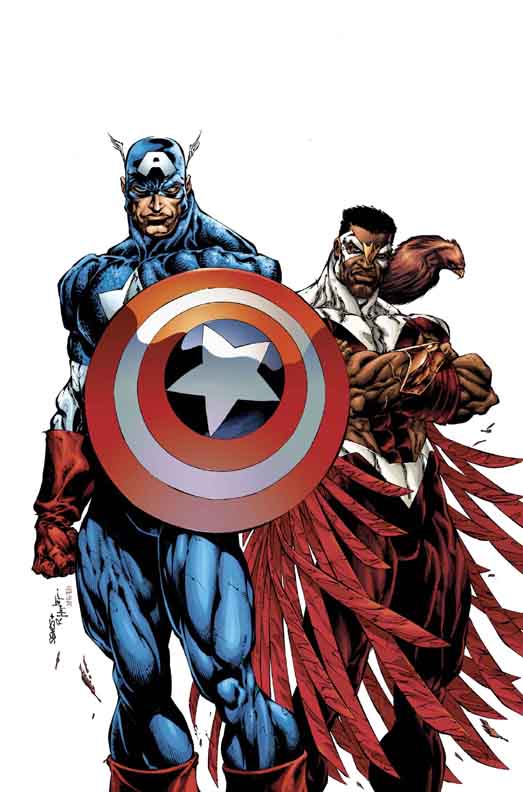
Capsule Reviews of Captain America & The Falcon #1-2
Issue #1: This series seems to have fallen into the love or hate bracket, and count me in former. Admittedly, I'm a Priest
fan. I like almost everything that he writes. His style just meshes with me, and this issue is no exception. He offers up
an intelligent story that really has me intrigued and surprised. The character development of the two title characters proved
to be the book's biggest strength, especially the parts with the Falcon. The art lets the story down just a tad, but not to
badly. Sears's art on this book is not nearly as strong as it was on CrossGen's The Path, but he does offer up some pretty
cool visuals, despites some overexagerration that doesn't real suit Priest's fairly down to earth script. Still, the art was
pretty good, and the story was excellent. This looks to be the start of a successful series. 8/10
Issue #2: You've got to trust Priest. If I've learned one thing reading his comics work, that's it. That trust already
begins to pay off halfway through this arc, as we have some questions answered. All questions are not answered though, as
Priest's plot remains mysterious and intriguing. His characterization of the two main characters is dynamic, and I like it
quite a bit. The art is not so strong in this issue. Sears tries to do something a little bit different, and I appreciate
that, but I'm not sure how well it's working. It's sort of a mixture of his superhero work and his darker stuff from The
Path and the result is somewhat confusing and a little overexagerrated even for a fan of stylized art like myself, but
it does have some appeal. Regardless, Sears's art does enough to keep the book enjoyable and is itself very good itself
at times, and when it is paired with Priest's excellent story, this book is very good. 7/10
Revies by Eliot "Tek" Johnson
| Firestorm #1 |
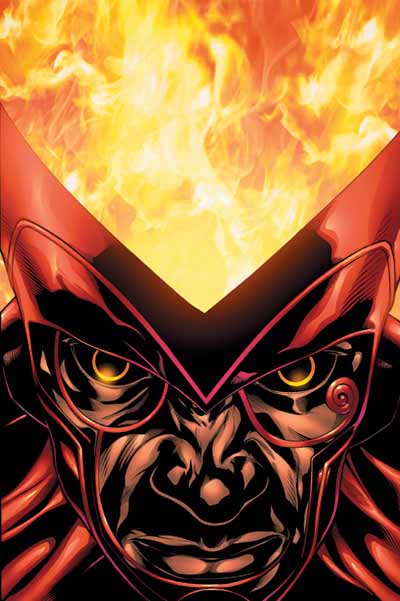
|
| Cover art by ChrisChross and John Dell |
Regarding: Firestorm
I'm all for racial diversity in comics.
When I first heard that Jason Rusch was going to be Black, I was very
excited. Not only was DC finally giving a Black character a book(At the moment, you can count the number of books solo starring
a Black character on zero fingers. There were more books starring Black characters in the seventies. It's 2004...but I digress),
but it was also in the role of an established hero, a hero with fans. Regardless of race, totally new characters, especially
super-heros, have not fared well in sales for quite some time. For a brief few seconds there, I was thinking that DC had finally
done something right with regard to racial minority heroes. In fact, with John Stewart in the JLA, and with him being farely
popular (and thus, with a chance to become THE GL), there might have even been hope.
Then, I read more into this situation,
and the more it doesn't sit well with me. The first thing that jumped out at me was that Jason would be working on the wrong
side of the law. I immediately started worrying about that. Why can't DC do a book about a middle class, average American?
Why does he have to work on the wrong side of the law? I'm not saying it's wrong to have any Black character to work on the
wrong side of the law. But, to have your one Black star doing so...then we have a problem. What message does that send?
Further, DC finally gives a black character a book, but they don't give that character A-List creators. Now, don't get
me wrong, Dan Jolley and ChrissChross could tear things up. I mean, they could just create the best damn super-hero stories
we've ever read. But, regardless, right now, Dan Jolley doesn't have a massive fan following, and neither does Chross. DC
has never put true A-List creators (Loeb, Lee, Johns, etc.) behind their black characters. That needs to be changed.
Changing
that would solve many problems with the comic industry. Right now, it seems as if comics fans believe in the myth of the "black
book" for black people. This is based on the fact that many of these books about black characters that are so labeled receive
great critical acclaim, but don't sell well. Admittedly, that also happens with other books, but it's almost guaranteed with
books starring black characters. Now, if a big name guy came aboard a book starring a black character, fans would follow,
and see, gradually, that there is no such thing as a "black book." These comics can be enjoyed by all.
All that said.
I haven't read the book. I don't know to what extent Jason will be involved in these illegal activities. I will, for better
or worse, be buying the first issue of this series, and I will judge from there. --Eliot "Tek" Johson
| Days Like This |
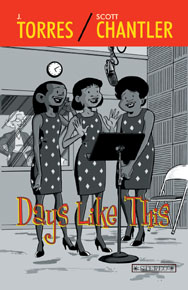
|
| Cover art by Scott Chantler |
Days Like This (Published by Oni Press)
Written by J. Torres, with art by Scott Chantler
This story takes places in the early 1960's, at the beginning of a new golden age of music. At the center of it all is
Harmony Plaza, a hit factory full of young songwriters, singers, and producers.
That is the setting for this graphic novel. The true meat of the story begins as the former housewife of a music mogul
with hopes of becoming a music moful herself, Anna Solomon heads to a talent show at her daugther's school. She has little
idea that at that show she will meet the three young women that will be the stars of what she hopes to be her new music empire.
Chirstina and her two friends come up on the stage and wow Solomon, setting the stage for the story.
As Solomon attempts to get Christina's father to allow her to participate in the group that she has planned, the
story really takes off. This conversation is very interesting from the standpoint of character interaction and also from the
realism of it. Anna is somewhat offensive to Christina's father without intention, while he simply wishes what his conservative
beliefs are called into question. After he storms off, the story picks up with some fun elements as Christina and Anna agree
that he "Never actually said no!" Anna along with the three girls, head to record a demo record.
The rest of the story continues in this vein, with the focus on character interaction and development. The constant battle
between Christina and her father intrigues the reader throughout the story, as Christina is forced to choose between to things
that she truly loves. Another interesting element of the story is that Anna is spending so much time with her new group (which
is called "Tina and the Tiaras"), that she is abandoning her daugther, who shows some feelings of resentment. Again, Torres
throws in some great interaction between these characters.
This story also features some great, realistic dialogue. The manners in which the young women and the adults speak contrast
charmingly, and the word choice seems all bout unapproachable. The plot is not the most original in the world, but Torres
manages to make it absolutely engrossing through his dialogue, development, and some just plain fun moments. The cartoony
art by Scott Chantler suits the tone of the story perfectly, and he wonderfully captures the characters' emotions. Wrap all
that up with a heartwarming ending and a beautiful production design by Oni Press and you have a winner. This Original Graphic
Novel (or, OniGN, if you will) was one of the best reads of 2003. If you can find it...buy it!
--Eliot "Tek" Johnson
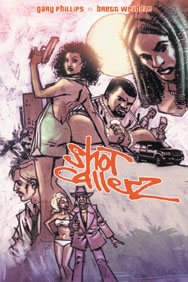
Shot Callerz TPB (Published by Oni Press)
Written by Gary Phillips, with art by Brent Weldele
As someone fairly new to the world of "small press" comics, I did not know exactly what to expect when I decided to read
a book from Oni Press called Shot Callerz. I'd heard of Gary Phillips as a novelist, but I'd never read anything
by him, and the artist was totally unknown to me. So, I wasn't sure if this series would be full of stereotypes or if it would
be unrealistic, or if it would even be readable.
I was pleastantly surprised, as I greatly enjoyed the story. It's extremely realistic, and it's full of tension. Shot
Callerz was an absolutely riveting read, and that's what was most impressive about it. I couldn't wait to see what happened
to the characters as I continued to read the story. Also, the realistic and witty dialogue added to my enjoyment of the story,
a story which centers around a young Black woman named Nea. Nea has been betrayed lost her cut of a robbery that she helped
pull off. She goes on a quest regain her money, but, in the end, she learns a lot about herself, in more ways than one. The
end has two shocking twists that I won't spoil, but totally shocked me.
The art, by Brent Weldele, is very nice. It's a little bit rough and confusing, but I like it a lot. Yes, the comic is
black and white, but as you read the story, the black and white becomes more and more enamoring. I'd say that Weldele maintained
the level set by Phillips.
The idea behind this series could easily have it fall into a stereotypical role, but, in the end, Phillips manages to
avoid this, and turn in a riveting, realistic read. This mini-series was very enjoyable, and I highly reccommend it.--Tek
| The Crew #1 |
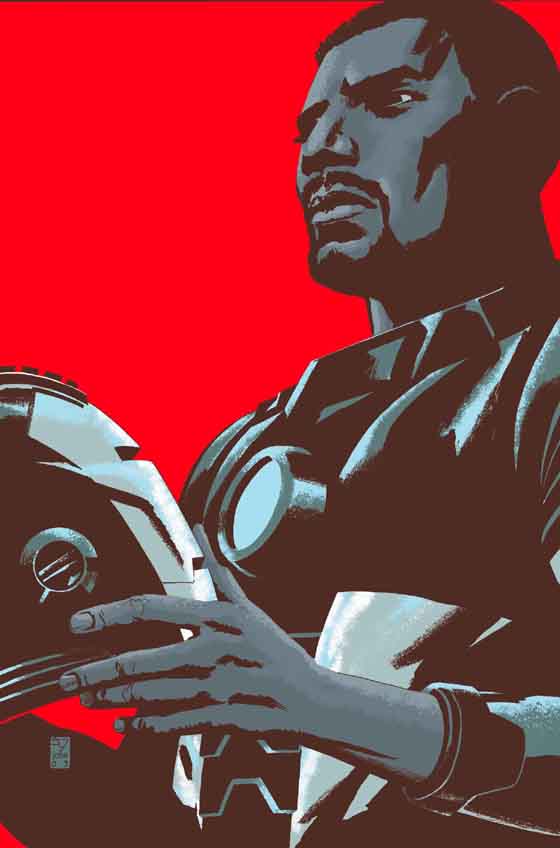
|
| By Christopher Priest (w) and Joe Bennett (p) |
The Crew #1 Review
Out of 5 rivets I give it a 3 1/2 rivets.
Why not a full 4 rivets? The only reason why it is a must read is it is the first issue of this series.
To be honest there was nothing in this issue that couldnt be summed up in a simple recap next issue.
And speaking of recaps, it would have been nice to have a page dedicated to filling the reader in on why James Rhodes
was without his armor, why he was bankrupt, or why he seems to be losing his mind early on in the story. Some readers
(like myself) might need some background.
A little attempt was made when they mentioned that he was (past tense) the C.E.O.
of Stark Enterprises and owned his own company. But that really didnt tell us anything. This was starting to really
irk me (as my momma would say) until I saw who the writer was.
Priest.
How could I have forgotten? The writer of the greatest comic never readThe Black Panther. After
reading his great run on The Black Panther I know he doesnt leave the reader on satisfied or lacking resolution. I have
yet to read an instance where Priest did not wrap up a subplot. I also suspect he will be giving us details as to why
James was broke, senile, and metalless. From what I have gathered from his work and his web-site, he puts a lot of thought
into his story arcs and they are extremely well thought out. I would love for him to write Detective Comics on a regular
basis.
Back to the comic: In searching for his sisters killer we see James isnt a punk when he isnt in his armor. He beats
up street thugs so easily that you wonder if had more than helicopter training. After that action scene (the only one
in the issue, well done tho) we meet the neighborhood Muslim, Josiah X. A stereotypical do-gooder but in this comic he off
sets almost every other more violent character in the comic. At the end of the story we see James comes down pretty
hard on X and his inability to inspire the community he is trying to better. And I question if James could have
been more tactful in the voicing of his opinion. But then I thought that maybe Priest wants us to realize that James
is not going to be a goody-goody hero. But a man with demons and ghosts (no they are not the same). He has his
faults just like you and I. Priest has begun to take us on a journey. A journey that will allow us to see if a
man (like you and I) can become a heroagain.
And no James Rhodes is the only hero in this issue. The latest Black
Panther (see current issues of The Black Panther to see what I mean) Kasper Cole makes an appearance. But like James
he is not in costume either. So in this superhero book we didnt see anything super. So maybe this book is about
heroes.
The Maniac Psycho
Founder of S.T.E.E.L.
OVERALL REVIEW of The Crew (seven issue series from Marvel)
In the end, I enjoyed The Crew more than I did Truth. Maybe it's just because the book is
written by Priest, but I really liked six out of seven of these issues. Also, Joe Bennett's art was very good. It was
a shame to see this series go, as it was of the better books on the stands each and every month, and it got to rarely
focused on issues in comics. --Tek3311

Marvel's Truth: Red, White, and Black #1
Written by Robert Morales. Art by Kyle Baker.
Synopsis:
The story opens in Queens, New York in July 1940. A young Black couple, Isiah and Faith, are attending The World
Fair's "Negro Week." The pair interchanges a little light-hearted conversation on about W.E.B. du Bois. Isiah decides to lead
the couple into a show where they can witness "A bevy of international beauties in their natural splendor." The man taking
tickets refuses their entrance, saying "They [the women] don't like to be looked at like they're animals." Isiah, rightfully,
is quite angered by this. He is about to punch the man who refused him entrance, when Faith holds him back. When the reader
sees Faith's hand, the reader also sees that Faith has an engagement ring on.
The story now heads to the "East of Broad" ares in Philadelphia in December, 1940. Maurice Canfield arrives home, he
looks like he was in a fight. He enters the house and greeats his mother, who is slightly upset by his blood-stained look.
Along with a Jewish friend of his, Maurice Edelman, Maurice went to New Jersey to organize a group of stevedores. One of the
other men at the meeting did not want to listen to a Black man and a Jew, and made a racist comment about both groups. This
led to what Maurice describes as a "raucus." Maurice's mother calls him a fool. Maurice then says "Why Momma? Becuase I think
we should stand up for ourselves? Because if enough people at the bottom learned to work together, there might be some advencement
for Negroes?" Maurice's mother responds that her comment was directed towards Maurice's recklessness. The conversation continues,
but is cut short when Maurice's father arrives home.
Jumping further into the future, the story shifts to Blue Nile Billiards in Cleveland in June 1941. An older Black gentleman
is shooting pool, when a voice calls from off panel, "Hey-hey Cap!" "Cap" is angered by this and says that "Only a fool who's
been incarcerated for six years would be so ill-informed to call me that, OR somebody looking for a whipping."
"Cap" the shows a small and asks the man who called him, Dallas Huxley, when he was let out. The pair decides to play
pool. "Cap" revelas he was busted down to sergeant. He tells Dallas to call him Mr. Evans. Dallas scratches his first shot.
Luke ( "Cap") then nocks two balls in right away. Luke says that he was busted down for pushing an officer, when the officer
said that a (Black) man's life was a trifle.Then there is a close up on the cue ball, with Luke saying "This is the only place
I get to shove ol' whitey around."
Then there is a two page spread of the attack on Pearl Harbor in December 1941.
Back in Cleveland, Luke appears as if he is about to commit suicide, when someone chouts "Didja hear? The Japs just bomber
the U.S.! We're in it now!" Luke then says "Well, all right..."
In January 1942 in Cleveland, Maurice is on trial for anti-war demonstrations. He is given the choice of doing twenty
years hard labor, redressing his actions, or enlisting and "serving his nation with honor."
One month later, in New York City, Isiah kisses his pregnant wife, Faith goodbye, saying "Don't worry, baby, I'm coming
back to you. I promise." The story wneds with Isiah saying "That was the first of the worst days of my life."
Review:
This was a very, very good comic book. It is entertaining and socially important. Kyle Baker's art takes a little getting
used to, but rather quickly is becomes very enjoyable. Just be prepared for a different style of art when you pick it up.
Morales writes brilliantly. He captures many of the problems faced by the Black American in the 40's. Plus I really began
to care about all of the characters after only one issue. When there are only about six pages for each character,
that is a true achievement. Morales has really set up what could be a true classic. --Tek3311
OVERALL SERIES REVIEW:
Unfortunately, this series was not nearly as good as the first issue indicated it would be, but this series ended up
being enjoyable. As much as I like Kyle Baker's art, I'm not sure he was right for this series. There was some very good character
interaction in this series, but it's middle was fairly weak. The ending was pretty good, however. All in all, I would suggest
the Truth Trade Paperback, which is coming in February, to anyone looking for a good read.--Tek3311
|

